Click on the article title to view it -
- Electrical Hazards
- What Is RCD Protection ?
- The Benefits Of Your Contractor Being NIC EIC Registered
- Upgrading Your Consumer Unit / Fuse Box To Meet Current Regulations
- The Ultimate Way To Configure Your New Consumer Unit
- LED Lighting -
Who Wouldn’t Want To Save Money On Their Electric Bill ??
Electrical hazards are invisible but deadly, causing fires and electrical shocks. These hazards are easily preventable if you use an NICEIC-
Government figures estimate that each year there are around:
 10 fatal and 2,000 non-
10 fatal and 2,000 non-
19 fatal and 880 non-
There are also about 12,500 electrical fires in homes across the UK each year. Although many incidents are caused by faulty appliances rather than the electrical installation itself, a properly installed and well-
Cables, switches, socket-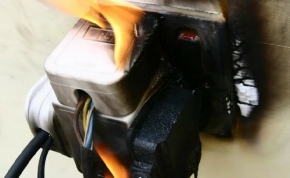
Whilst it is relatively easy to make an electrical circuit work – it is far more tricky to make the circuit work safely. To avoid the dangers that electricity can create it is essential that electrical work is carried out only by those with the correct knowledge, skill and experience in the type of electrical work to be undertaken.
The Electrical Safety Council published the results of their National Consumer Survey and found that:
•42% of those surveyed stated they had never had their electrics checked
•32% of DIYers stated they had experienced one or more electric shocks while carrying out DIY
•59% of people do not use qualified electricians when carrying out electrical work
•48% of those surveyed did not know that their electrics should be checked at least every 10 years.
(This article has been reproduced from the official NIC EIC website)
What is RCD protection and how does it work?
A question that I get asked quite a lot is "what is RCD protection".
I explain it to people in simple terms so they can understand it like this.
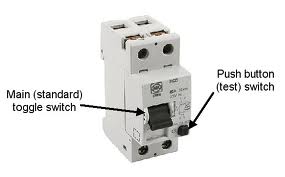 An RCD monitors the electrical current flowing out of the live wire and measures it against the current flowing back through the neutral wire. Under normal circumstances the currents flowing should be the same with no differential and the RCD operates normally, continuing to supply the electricity around the circuit.
An RCD monitors the electrical current flowing out of the live wire and measures it against the current flowing back through the neutral wire. Under normal circumstances the currents flowing should be the same with no differential and the RCD operates normally, continuing to supply the electricity around the circuit.
If an earth fault occurs, like for instance you touch a live wire and get an electric shock, you interrupt the current flowing through the circuit and it travels through you to earth instead of flowing back through the neutral wire. The RCD instantly detects the current differential and knows there is an earth fault somewhere in the circuit. The RCD trips off within milli-
RCD’s also have mechanical components inside them. That is why it is important for you to test your RCD's in your fuse box every 3 months by pressing the test button. If your RCD is working properly it should trip off as soon as you press the button. If however, when you press the test button and it does not trip off due to a mechanical malfunction inside the RCD you will need to get it replaced as soon as possible.
Imagine the above scenario when you were touching the live wire and getting an electric shock. If the RCD was ‘stuck’ in the on position due to a mechanical failure, it obviously would not be able to trip off and would carry on supplying electricity around the circuit, possibly with serious or even fatal consequences !!
Please Note Though : Having RCD protection does not eliminate the chances of getting an electric shock, it does however greatly reduce the risk of having a prolonged, and potentially harmful or even fatal electric shock.
The Benefits To You, As A Customer, Of Your Contractor Being NIC EIC Registered
So why would you choose a contractor who is NIC EIC registered?
Firstly NIC EIC stands for National Inspection Council for Electrical Installation Contractors.
 A registered installer has to have a certain level of electrical qualification before even being allowed to register on the scheme in the first place, which means you can be confident that the contractor turning up to do work for you has achieved a certain level of electrical knowledge.
A registered installer has to have a certain level of electrical qualification before even being allowed to register on the scheme in the first place, which means you can be confident that the contractor turning up to do work for you has achieved a certain level of electrical knowledge.
Also, every installer has to pass an initial assessment of competent workmanship and practical knowledge before being accepted on the scheme.
Every installer is assessed each and every year to make sure they are keeping up to date with the current electrical regulations and workmanship standards are maintained.
Every installer has to have a minimum of £2million liability insurance cover in the event that someone may get injured or something gets damaged as a result of the workmanship of the contractor.
Every job registered under the building regulation notification scheme through the NIC EIC has an insurance backed warranty, so even in the eventuality your contractor stops trading your work will still be covered under the NIC EIC scheme.
So to answer the question "why would you, as a customer, choose an NIC EIC registered installer" it has to be peace of mind knowing that someone working in your home with a potentially dangerous yet invisible force like electricity has achieved and is continually assessed to a certain level of competency.
For more information about the NIC EIC scheme visit the official NIC EIC website by clicking here.
Upgrading Your Consumer Unit / Fuse Box To Meet Current Electrical Regulations
So why is it necessary to upgrade your consumer unit / fuse box to meet current BS7671 -
Well to get straight to the point -
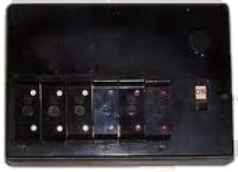 If your fuse box looks like this one, you seriously need to be considering upgrading!
If your fuse box looks like this one, you seriously need to be considering upgrading!
The old style re-
By today's standards, the old type fuses take far too long to disconnect the electricity supply in the event of a fault occurring -
Just to give you some idea of the differences, a modern RCD circuit breaker in a domestic consumer unit will trip within 0.3 of a second if an earth fault occurs of only 30 milli-
Compare this with the old style fuses -
Electrical Fire Risk -
The solution is to get your fuse box upgraded to the current RCD protected type. At the same time your earth bonding arrangements will have to be upgraded as well. This means connecting your water and gas (if applicable) pipes with a 10mm.sq earth wire to your main earthing terminal.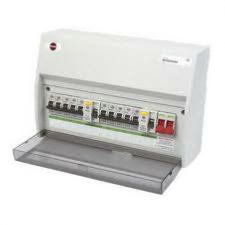
If you have a look at the consumer to the right you will notice it has 2 RCD modules in it, each protecting 5 circuit breakers. This is known as a split load consumer unit. The reason why it is split is for convenience and safety. If one of the 10 circuits develops an earth fault, the corresponding RCD which is protecting that circuit will ‘trip’ and disconnect power to all 5 circuits. However you would still have power to the other 5 circuits. So for instance if you had 1 circuit for ground floor lights and a different circuit for upstairs lights (a very common arrangement), the correct way to wire up the split load consumer unit would be to connect those circuits into separate RCD modules so in the event of one of them ‘tripping’ you would not lose all lighting in your home. The same principle applies for ground floor and upstairs sockets.
The Ultimate Way To Configure Your New Consumer Unit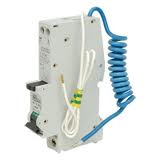
The best way possible to configure the domestic consumer unit is to have individual RCD protection for each circuit in your home. This is achieved by using a BS / EN 61009 RCBO circuit breaker for each circuit. This may sound technical but simply put this device does the job of an RCD and an overload circuit breaker within the same module. So for instance an RCBO device for a lighting circuit would have an overload tripping disconnection at 6 amps for short circuit faults plus an earth leakage tripping disconnection of 30 milli-
This is the ultimate way to protect your home. If a fault develops in a circuit only that circuit is disconnected leaving all other circuits with power. Therefore being safer and more convenient.
Imagine if a fault developed in a light fitting, causing the RCD in the consumer unit to trip off because of an earth leakage fault in the lighting circuit. Maybe the same RCD unit supplies power to the kitchen socket circuit where the fridge & freezer are plugged in. The fridge & freezer will lose power and potentially the entire contents could be ruined!
As you would imagine, this is a more expensive solution -
If you’ve not read my article about how RCD’s work click here.
Led Lighting -
LED lights & light bulbs have come a heck of a long way in recent years. Long gone are the bulbs that used to display all the little diodes and were only just bright enough to be used as a night light.
There is a replacement LED bulb for every type of original bulb you can think of.
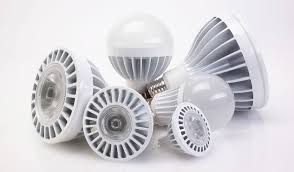 The light output is the same if not better than the original ones too.
The light output is the same if not better than the original ones too.
Many households have multiple ceiling spotlights with 35 or 50 watt halogen bulbs in each of them.
A direct LED replacement bulb can be as little as 3.5 watts! A typical 50 watt halogen replacement LED bulb is 5-
If used in a room which is regularly occupied, which may have 6 or 8 spotlights in it, that could reduce your energy consumption from 400 watts down to just 40 watts! Less than an original ‘old style’ 60 watt centre pendant light bulb!
There are more benefits to LED bulbs than just energy savings too. LED bulbs will last a lot longer and they operate at much cooler temperatures.
It has been proven that LED bulbs save money over time due to their energy efficiency and long life.
Be careful when buying Led bulbs though. There are some poor quality ones out there that will not last as long as they should. Buy ones from a reputable supplier who will recommend the right bulb for the job, that doesn’t mean paying the earth for them either. Because LED technology has become very popular the cost of quality bulbs has come down massively over recent years.
Light output from early LED bulbs used to be a cold bluish white which put a lot of people off installing them in their homes because it gave a cold, clinical atmosphere. Modern LED bulbs now come in a range of colour temperatures to create the right atmosphere for any room. Well worth considering the LED option nowadays.